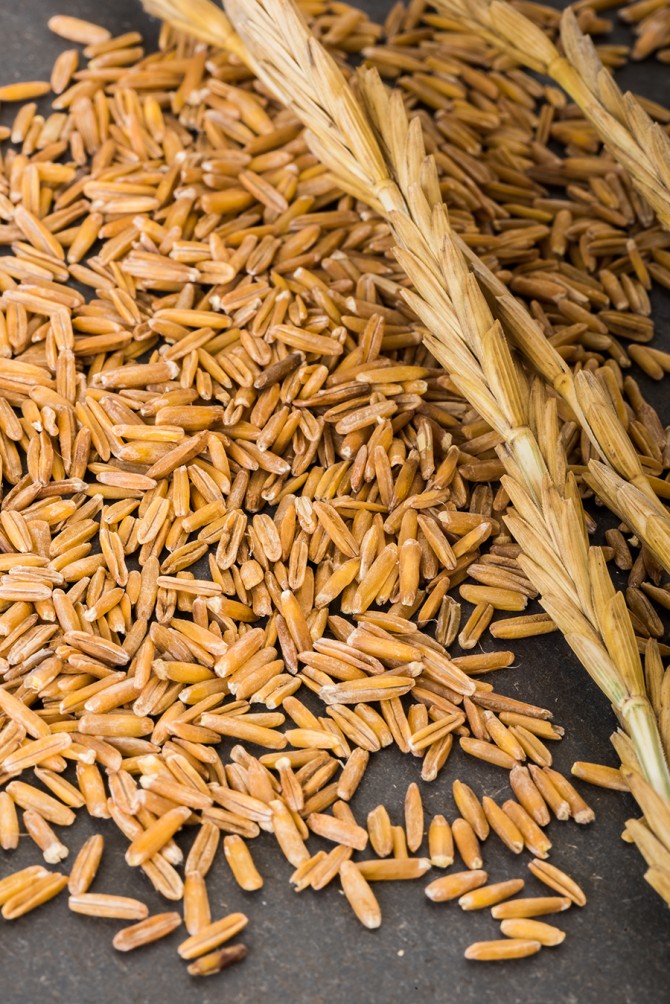Farmers get guidance on growing new perennial grains
While most industrial grain crops are annuals that must be replanted every year, a new perennial grain called Kernza® has hit the markets with growing interest from restaurants, bakeries and brewers.
Growing grain from newly developed perennial plants that can last many years in the field improves soil health, and reduces fertilizer and pesticide use, and agricultural runoff. Annual grain production often involves tilling the soil, which destroys beneficial soil microbes and leeches nutrients into waterways.
Though researchers have been experimenting with perennial grains for a long time, interest has increased in the last few decades due to the ecosystem services they provide.
Kernza, a domesticated version of intermediate wheatgrass, has the drawback of low yields and small grains. While breeders work to increase grain sizes and yields, farmers must also learn how to use these new grains in their crop rotations for optimal effect.
A new Cornell paper published March 21 in the journal BioSciencedescribes strategies to integrate and manage Kernza to get the most out of the new crop.
“I feel like we’re at a tipping point right now with perennial grains and domesticated Kernza, a perennial grain crop, is leading the charge,” said Matthew Ryan, assistant professor in the Soil and Crop Sciences Section of the School of Integrative Plant Science and lead author of the paper. “You can plant it once, and it will last for several years.”
Kernza was developed by the Land Institute in Salina, Kansas. Other perennial grains are being created by hybridizing high-performing domestic annual species with closely related perennials such as wheat, rye, sorghum and rice. And, a new sunflower, called Silphium, has resulted from domesticating a wild perennial plant species.
Ryan, whose research focuses on sustainable cropping systems and perennial grains, finds that in order to offset Kernza’s relatively low yields, it’s important to take advantage of its strengths.
“One of the most obvious and easiest ways is to rotate it with annuals and try to achieve some kind of multifunctionality within an existing rotation,” which would improve soil health while the land is in perennial grain before it goes back into production of annuals, Ryan said.
Perennial plants have deep root systems that keep soil covered and in place, preventing erosion and reducing runoff. This is important due to increasingly frequent extreme rain events and because New York state farmers often need to farm on sloped land.
Many perennial grains also serve as an excellent forage as well as a grain, a dual purpose that could benefit farmers.
“When you look at the economics, that seems to be the most viable approach in terms of profitability,” Ryan said. The grains can also be intercropped with legumes that add nitrogen to soil.
“We’re working with four farmers right now in central New York, and they have both Kernza and perennial cereal rye on their farms,” Ryan said, adding that when perennial grains are marketed as a specialty crop, they can fetch higher prices for farmers than conventional varieties. “I think there is going to be increased adoption, as there is quite a bit of demand right now and a lack of supply. We are going to see more and more products that are incorporating perennial grains into them.”
Kernza is currently being integrated into mainstream food. For example, Long Root Ale made by Patagonia Provisions, and Gold, a blonde ale made by Bang Brewing in St. Paul, Minnesota, both use Kernza. Restaurants – The Perennial in San Francisco and Birchwood Café in Minneapolis, to name a couple – serve dishes and breads made with Kernza. Zachary Golper, owner of Bien Cuit bakery in Brooklyn, has been extensively testing baking with the grain. And now General Mills has expressed interest and contributed $500,000 to further research into the climate impacts, production and breeding of Kernza.
Kernza is a registered trademark of The Land Institute.
This article is written by Krishna Ramanujan and was originally published in the Cornell Chronicle on

